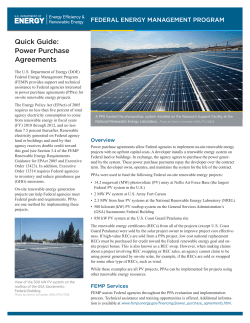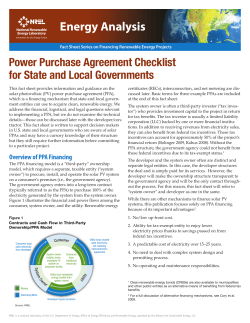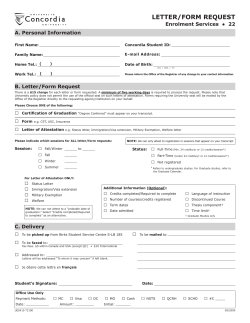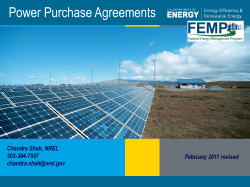
Renewable Energy Power Purchase and Net Metering
Renewable Energy Power Purchase and Net Metering Credit Purchase Agreement Guidance for State Entities Prepared by the Leading by Example Program, Department of Energy Resources1 Issued December 2013 This guidance is designed to provide state agencies, authorities, and public colleges and universities with information on Power Purchase Agreements (PPAs) and Net Metering Credit Purchase Agreements (NMAs). The Department of Energy Resources provides this information as guidance only and strongly encourages all state entities to consult with their legal, procurement, and fiscal officers to ensure adherence to all relevant laws and regulations governing these types of projects. Generally, PPAs and NMAs are agreements with an outside party that owns and operates an energy generating system. Traditionally, PPAs are set up as a purchase of power from an on-site system while NMAs are set up as a purchase of credits from an off-site system. Both PPAs and NMAs, however, can be used for on-site or off-site installations in which none, some, or all of the power is used on-site. While on-site systems provide the most visible commitment to renewable power, long-term agreements for large off-site installations can provide the necessary support for the installation of renewable projects in the Commonwealth. While PPAs and NMAs can be used for non-renewable energy producing systems, this guidance is focusing specifically on renewable systems. For purposes of this guidance, the “public entity” is the public agency, authority, or college/university entering into an agreement. The “project owner” is the outside party that owns the systems entering into an agreement. 1. What is a Power Purchase Agreement (PPA)? PPAs are contracts in which the public entity buys the electricity generated by a renewable energy system from the project owner. In general, PPAs may incorporate either a fixed price per kWh over a fixed term or a fixed price per kWh with an agreed upon annual escalator. Other pricing structures may be negotiated with a PPA provider. The project owner is usually responsible for installation, interconnection, operation, maintenance, and repair of the renewable energy system for the duration of the contract. PPA contracts are often as long as twenty years. Public entities can enter into PPAs for on-site or off-site installations of renewable power and can consume all, some, or none of the power being generated. Public entities pay for power generated, which, if consumed on-site reduces grid electricity consumption and utility costs. Alternatively, public entities may pay for power generated that is not consumed on-site and receive net metering credits, thereby reducing utility bills. See question #3. From the perspective of the public entity, PPAs usually: (a) require no or minimal upfront costs; (b) provide a known and predictable price of power; (c) provide long-term cost savings; and (d) support renewable energy installation in the Commonwealth. For the project owner, the PPA provides a fixed long-term revenue stream to finance project development, installation, and operation. PPAs in Massachusetts are permissible in all investorowned utility territories. If served by a Municipal Light Plant (MLP), the public entity should consult with the MLP regarding eligibility of a PPA. In a PPA, the project owner typically, though not always, receives all of the direct benefits associated with federal tax incentives, construction incentives, net metering credits and renewable energy certificates (RECs) associated with the project.2 Such benefits can be significant, however, the benefits of the project should impact the electricity price of the PPA (e.g. greater benefits/incentives to the project owner should result in lower-priced electricity for the public entity). Please note that while public entities can benefit from construction rebates, net metering credits and RECs, they are not eligible for any federal or state tax credits, which is often why PPAs can be more cost effective than owning and operating renewable energy installations for public entities. 1 This document was prepared in consultation with the Massachusetts Department of Public Utilities and Division of Capital Asset Management and Maintenance. 2 Go to www.mass.gov/eea/energy-utilities-clean-tech/renewable-energy/rps-aps for more information on the Massachusetts Renewable and Alternative Portfolio Standards. The precise terms of a PPA are subject to negotiation. See question #11 for issues to consider when entering into a PPA. 2. What is a Net Metering Credit Purchase Agreement (NMA)? A NMA is designed to reduce electricity costs for the public entity while providing consistent energy payments to the project owner over the term of the contract, which helps finance and support renewable energy installations. As in a PPA, renewable installations developed as part of a NMA are owned and operated by a project owner. In a NMA, the project owner enters into a contract with the public entity who agrees to the long-term purchase of some or all of the net metering credits created by the renewable energy facility as the “host customer.”3 By purchasing net metering credits, the public entity realizes a monetary credit on its monthly utility bill and pays the project owner an amount less than that monetary credit. The host customer (public entity) may allocate some or all of their credits to one or more accounts associated with the public entity and/or other public entities, as long as the accounts are located in the same utility load zone as the renewable installation. Only the host customer may allocate net metering credits. Host customers may change credit allocations up to two times per year through Schedule Z of their interconnection application.4 In general, NMAs are structured as a fixed discount from the utility rate over a fixed period of time in which the public entity receives 100% of the value of net-metering credits on their utility bill and pays the project owner a fixed percentage of that value, such as 95%, for a guaranteed savings of 5%. NMAs may include a floor price for utility rates, below which the owner will not guarantee savings to the public entity. Under this scenario, the payments made to the project owner will be directly related to the utility net metering rate (see question #3). The precise terms of a NMA are subject to negotiation. See question #11 for issues to consider when entering into a NMA. 3. What is net metering? According to the Department of Public Utilities, “Net metering allows customers of certain electric distribution companies to generate their own electricity in order to offset their electricity usage. All customer classes are eligible for net metering. Common examples of net metering installations include solar panels on a home or a wind turbine at a school. These installations are connected to a meter, which will measure the net quantity of electricity that the customer uses (“retail meter”). The retail meter spins forward when the customer uses electricity from the distribution company, and it spins backward when the customer generates excess electricity (thereby “exporting” electricity to the electric grid). A special retail meter (also called the “net meter”) is required to allow for the “netting” of usage and generation, especially when there may be exporting of electricity.”5 For net metered projects, electricity first serves the electric needs of the host customer. If the generation from the net metering facility exceeds the electricity needs of the host customer, then the electricity is exported to the grid. When the electricity is exported to the grid, the electricity is referred to as excess generation. As a result of net metering, excess generation that occurs within a billing period (e.g. a month) can offset electricity that the host customer buys from the utility during a different time of the billing period. In this regard, the total generation of the net metering facility is “netted” against the total usage of the host customer over the course of a billing period. If a host customer has generated more electricity than they use over the billing period, then the host customer has net excess generation. The net excess generation is converted via a formula into net metering credits. Net metering credits are monetary credits. The value of metering credits (i.e. the formula used to calculate the net metering credits) is determined by many factors, including the class of the net metering facility (e.g. class I, II or III), whether the facility is public or private, and the host customer’s electric rate, as designated by the utility company. The host customer can keep the net metering credits on the same account (e.g. accrue net metering credits during 3 According to the Department of Public Utilities, “The Host Customer is the customer of record with the electric distribution company. The person or entity whose name appears on the account is the Host Customer of a net metering facility.” 4 Public entities should check with their electric distribution company for more information about Schedule Z. 5 http://www.mass.gov/dpu/netmetering one time of the year in order to offset bills in a different time of the year) or allocate the net metering credits to other accounts. Net metering credits can be applied to other accounts as long as those accounts are in the same utility service area and same load zone (geographic areas defined by utilities). As an example, a host customer could allocate net metering credits to additional accounts within the same agency or allocate to other accounts (as mentioned above, please note that host customer of public net metering facilities can only allocate net metering credits to public entities). For public net metering facilities, net metering credits include the basic service supply rate as well as distribution, transmission, and transition charges, however, for projects less than 60 kilowatts (“kW”) that are not wind, solar, anaerobic digestion, or agriculture projects, the net metering rate is equal to the average ISO New England clearing house price. For a detailed explanation of the value of net metering credits, see http://www.mass.gov/eea/grantsand-tech-assistance/guidance-technical-assistance/agencies-and-divisions/dpu/net-metering-faqs.html#twentythree. Net metering rules apply to all utility territories in the Commonwealth except for those within MLP areas. Some MLPs may agree to net metering with a specific site or project but there are no state-wide rules governing net metering in MLP territories and such arrangements are negotiated between the site and/or project developer and MLP. Net Metering Example (numbers are for illustrative purposes only and do not reflect any actual usage, generation, or costs) 4. What are the benefits of public vs. private net metered projects? The net metering rules provide for a special category of net metering facilities- public net metering facilities. Public net metering facilities are entitled to special benefits when compared to private net metering facilities (see below). In order for a project to be classified as a public net metering facility, the project must be eligible for net metering and the host customer must be a public entity. Public projects have distinct advantages over private projects, including: Larger maximum capacity: If a net metering facility’s host customer is a public entity, the system falls under the public net metering cap and can be up to ten megawatts (“MW”) in size, as opposed to a private project which cannot exceed two MW. Please note that individual units (e.g. a wind turbine) can be no larger than two MW. Higher credit value for projects over one MW: For projects under one MW, both private and public entities are credited for the supply, transition, transmission, and distribution costs associated with electricity bills. However, for projects over one MW, public entities continue to receive credit for the distribution charges while private entities do not, resulting in a significantly higher credit value for public projects. See question #3 that discusses how the actual credit value is calculated. 5. What projects are eligible for net metering? The following project types are eligible for net metering: Any generating facility less than 60 kW; Any generating facility up to two MW using wind, solar, or anaerobic digestion; Any renewable energy project up to two MW at a farm; and Any wind, solar, or anaerobic digestion project with a public entity as the host customer can be sized up to ten MW. o Explanatory Note: A public net metering facility may have multiple units with a two MW maximum capacity per unit. Units are defined as the number of turbines (wind) or number of engines (anaerobic digestion). Solar facilities can self-designate the number of units as long as there is at least one inverter for every two MW of capacity. In order to enter into a NMA, the installation must be located within the same utility load zone as the host customer. Host customers may also assign credits to one or multiple accounts within the same utility load zone. Public entities may only allocate credits to other public entities. Please note the 10 MW cap for net-metered facilities per agency described in detail in question #9. 6. What are the options for public entities to procure PPAs and NMAs? Public entities have various options for entering into PPAs and NMAs, including: Option 1: Competitive Solicitation For agencies wishing to do a competitive solicitation for either a PPA or NMA, the procurement procedures vary depending on whether or not the construction of the renewable project is physically on state property. Additionally, the guidance below may vary depending on whether the agency is subject to the oversight of the Division of Capital Asset Management and Maintenance (DCAMM) and may differ depending on procurement requirements applicable to a specific public entity. a. For PPA and NMA projects with a value of less than $1 million that require on-site construction, agencies may request delegated authority from DCAMM to develop and issue a competitive RFP through Chapter 25A Section 11C or 11I . For all on-site projects with a total value of more than $1 million, DCAMM is statutorily required to manage and oversee the procurement and agencies should consult with DCAMM on development of a competitive procurement. Model solicitation and contract documents for energy service agreements may be found on the DCAMM website: http://www.mass.gov/anf/property-mgmt-and-construction/facilities-mgmt-and-maintenance/energyand-sustainability/energy-performance-contracting-program.html. b. For projects that do not involve the use of state land or property for any construction, executive agencies wishing to conduct a competitive procurement for energy and/or energy credits may develop and issue a competitive RFP under 801 CMR 21.00 et seq. Please note, for entities subject to 801 CMR 21.00, the solicitation for a PPA requires advance permission from the Operational Services Division (OSD) to procure energy outside of the existing Statewide Contract for Electricity (ENE30). There is a specific policy that documents the process to secure advance permission from OSD. See, OSD Policy Guidance 05-19 - Procurement and Contract Management Policy Changes (June 2, 2005) available on OSD’s website http://www.mass.gov/osd. Since there is no applicable Statewide Contract for NMAs, entities may proceed directly with a competitive RFP under 801 CMR 21.00. Entities not subject to 801 CMR 21.00 should adhere to all appropriate and applicable procurement requirements. Option 2: Group Purchasing of Energy In general, section 137 of chapter 164 of the Massachusetts General Laws, authorizes public entities, unless located in an area served by a municipal light department, to participate in programs organized and administered for group purchasing of electricity that has been competitively procured, among other enumerated commodities, services, or similar products. Further, under this section, the state disposition of real estate shall not require competitive bidding when part of a PPA or NMA, which falls under such group purchasing programs. Section 137, as amended in 2012, provides as follows: “[n]otwithstanding any general or special law to the contrary, (i) any non-profit institution in the commonwealth or any agency, executive office, department, board, commission, bureau, division or authority of the commonwealth, including the executive, legislative and judicial branches of the commonwealth, or of any political subdivision thereof, or of any authority established by the general court to serve a public purpose, may, unless located within the boundaries of a community served by a municipal light department, participate in and become a member of any competitively procured program organized and administered, under this chapter, by or on behalf of any public instrumentality of the commonwealth or of any subsidiary organization thereof for the purpose of group purchasing of electricity, natural gas, telecommunications services or similar products; (ii) the disposition of municipal or state real property by lease, easement or license for renewable energy shall not require competitive bidding when part of a power purchase agreement or a net metering agreement in a program organized and administered under this section; (iii) any agency, executive office, department, board, commission, bureau, division or authority of the commonwealth, including the executive, legislative and judicial branches of the commonwealth, may, on behalf of the commonwealth, dispose of real property, by lease, easement or license, which is part of a power purchase agreement or net metering agreement in a program organized and administered under this section, including, but not limited to, construction of renewable energy projects on state property; and (iv) any renewable energy project which is part of a power purchase agreement or net metering agreement in a program organized and administered under this section and considered to be public construction shall be subject to sections 26 to 27D, inclusive, of chapter 149.” M.G.L. c.164, §137, http://www.malegislature.gov/Laws/GeneralLaws/PartI/TitleXXII/Chapter164/Section137. In sum, this section provides an exemption from conventional procurement, which would otherwise be applicable to procuring a PPA or NMA, including an accompanying disposition of real property. This exemption is not without bounds, however, therefore agencies should ensure that any entity proposing an agreement under this section is doing so in compliance with all provisions of the law, including, but not limited to, a competitive procurement process, appropriate licenses, and clear corporate or institutional authority to act on behalf of public entities. More specifically, there may be licensure requirements or other approvals issued by the Massachusetts Department of Public Utilities for entities that seek to function as aggregators, cooperatives, or electricity brokers. For example, while competitive suppliers must obtain a license from the DPU, that does not authorize them to establish an energy purchasing cooperative. Entities acting as a cooperative on behalf of other entities must obtain an “Energy Broker” license. Moreover, agencies should understand how the entity in question either is or is acting on behalf of any public instrumentality of the commonwealth or of any subsidiary organization thereof for the purpose of group purchasing of electricity, as specified in Section 137. Finally, agencies should review documentation of all project proposers in order to understand how any particular program’s membership process and overall mission align with operating on behalf of public entities. While soliciting additional pricing and reviewing other terms and conditions is not required, it may be helpful to ensure that the Commonwealth is receiving the best value. 7. What are the benefits and drawbacks of PPAs and NMAs to public entities? Generally, PPAs and NMAs represent ways of supporting clean, renewable energy without incurring potentially significant up-front costs that are associated with on-site renewable installations that are owned by the public entity. As described in questions #1 and 2 above, PPAs and NMAs have different characteristics that result in distinct benefits and drawbacks. Upfront Costs o Both PPAs and NMAs usually require no upfront capital, although in some cases up-front payments may help reduce the initial and long-term cost of electricity. Installation Issues o On-site installations, whether supported by PPAs or NMAs, require structurally sound roof space or open space on which to build. o PPAs or NMAs for off-site installations eliminate any space or structural issues, as well as any construction contract oversight/management on the part of the public entity. Ongoing Maintenance o Systems hosted but not owned by a public entity (for both PPAs and NMAs) typically require the owner and not the public entity to maintain the system. Electricity Costs o PPAs generally provide the public entity with a pre-determined rate of electricity and can include periodic cost escalations. (e.g. $0.XX per kWh of electricity consumed with an X% annual escalation rate). o NMAs provide cost savings to public entities that is based on the differential between the applicable net metering credit value and a discount agreed to by the project developer and host entity. NMAs can include a floor price below which discounts will not be provided. 8. Can a public entity enter a PPA/NMA if it has a competitive supply contract for electricity? Generally, public entities can enter into a PPA or NMA even if that entity has a competitive supply contract for electricity. Public entities should remember that PPAs and NMAs will reduce the amount of grid electricity purchased and/or the total costs that appear on monthly utility bills. When public entities enter into a PPA or NMA, it is critical to understand how the reduction in electricity use and/or the credits applied to their utility bills will interact with competitive supply contracts. In many cases, electricity supply costs are billed separately from utility bills, meaning that utility bill charges are associated with electricity transmission and distribution, not electricity supply. If a PPA or NMA is too large, the net metering credits may exceed the utility bill costs, resulting in excess credits on the utility bill that may never accrue to the public entity. Additionally, a public entity will want to ensure that any power purchased for on-site consumption does not reduce total consumption below any minimum thresholds established by the competitive supply contract, which may result in penalties or reduced savings. In all cases, it is important for public entities to review all contractual obligations and consult with appropriate legal, procurement, and fiscal staff before entering into long-term contracts. 9. Are there any limits to the number of net metered projects a public entity may enter into? Each public entity can only be a host customer for up to ten MW of net metering capacity. According to the DPU Order Adopting Regulations 11-10-A, an entity means cities, towns, or state and federal departments and agencies. Aside from state and federal departments and agencies, all other governmental agencies are determined on a case-by-case basis. The DPU also noted that each classified entity includes all of its subparts. For example, the Department of Correction and all of its facilities are considered one entity, as is the Mass. Water Resources Authority or Fitchburg State University. An agency with multiple locations across the state can only be the host customer for public net metering facilities if the total capacity is ten MW or less. There is no limitation, however, on the amount of net metering credits an entity can be allocated from other entities. Additionally, agencies may install more than ten MW of on-site generation as long as such generation is not net metered. Regardless of the entity-specific cap, there is an overarching net metering cap for public projects in each utility territory equal to 3% of the highest historical peak load in that utility territory. Statewide, the 3% cap is approximately 333 MW of net metered generation for public entities. 10. For state entities, what are the leasing rules I need to follow and should I be in touch with DCAMM? Option 1: Competitive Solicitation In a competitive process managed by a public entity, the procurement of PPAs and NMAs that requires the use of state property generally requires a lease of that state property to the project owner. Disposition of state property by lease for most state agencies requires legislation authorizing the transaction before it can occur; see generally section 34 of c. 7C of the Massachusetts General Laws (DCAMM may only dispose of property by lease “when authorized by the general court. . .”). As leases are generally required to secure financing for developers to complete a PPA, it follows that at present, PPAs and NMAs that are procured competitively cannot be completed on state property absent legislation authorizing the lease of that property. DCAMM is exploring alternative options to allow for a lease as part of the competitive process in procuring a PPA. Option 2: Group Purchasing Process Section 137 of Chapter 164 described in Question #6 gives public entities the authority to enter into a PPA or NMA and corresponding real property lease without going through a competitive process or receiving the approval of another agency. However, when considering entering a lease arrangement that is part of a non-competitive procurement, it is recommended that the public entity consult with DCAMM, an agency with regulatory oversight over the leasing of Commonwealth real property. In general, agencies are encouraged to consider the following: Review title to any land proposed for a PPA or NMA. There are several potential restrictions upon Commonwealth-owned real estate of which entities may not be aware. DCAMM may be able to assist with any title search upon request. For example, Article 97 of the Massachusetts Constitution contains restrictions on use of certain publicly-owned parcels. Review any existing planning documents. DCAMM, the state entity itself, or another Commonwealth agency may have in its possession a planning document contemplating use of the property, which may be in conflict with use of the parcel for a long-term PPA or NMA. 11. What are some issues to consider in setting up a PPA/NMA? When considering a PPA or NMA, there are many questions that a public entity should review. Below, we have highlighted some important issues. The list is not all-inclusive and DOER strongly encourages public entities to conduct additional legal, procurement, and fiscal review of processes and documents associated with PPA and NMA projects. PPA or NMA – consider which contracting method is most beneficial for the public entity. PPAs usually provide price certainty, while NMAs usually provide guaranteed savings. Please note that the price of a PPA could provide savings (perhaps in excess of the savings associated with a NMA), but the savings are not guaranteed. Contract Term – Ensure that all agreements address the duration of the contract, which is often twenty years, and any equipment removal provisions (PPAs only) at the end of the contract duration. Pricing – While there may be different pricing structures (see questions #1 and 2), public entities should ensure that the pricing structure is clearly laid out, possibly with an initial price and an escalator. Public entities should consider their current electricity rate and projected rates when evaluating any contract pricing. Net Metering (see also questions #3 and 5) - Net metering may not be available if a site is served by a municipal light plant. RECs – Renewable Energy Certificates, including SRECs for solar projects, provide a revenue stream that help to make PPAs and NMAs cost-effective. Public entities should be aware of issues around claiming the renewable energy attributes and greenhouse gas emissions reductions from the project if the project owner is selling the RECs associated with the project. Property tax - Most large-scale solar projects installed on state-owned property by for-profit entities, are subject to local property taxes. Property taxes in those cases are assessed by the municipality directly to the lessee (i.e. the for-profit owner), under M.G.L. c. 59, §2B. State entities should be aware that leasing state land to a private developer may result in changes to property tax assessment and affect the economics of a project. Sites and/or the renewable power developers may be able to negotiate a “payment in lieu of taxes” (PILOT) with the municipality instead of an assessed property tax. Procurement – As stated previously in this guidance, public entities should evaluate and determine the appropriate procurement method for the contract. Public entities can either procure competitively or contract directly with a group purchasing entity as described in question #6 above. Other requirements - Ensure that the PPA contains any and all provisions necessary for the conduct of public construction and adequately protects the public entity from liability. These provisions should include, but not be limited to: o indemnification against loss; o insurance; o performance bond; o removal bond; o guaranteed commercial operation date; o guaranteed annual electrical output of the system; o DCAMM certification for Contractor performing the work if construction is building-related; o purchase option of the equipment at the end of the contract term; and o a requirement that the developer pay all applicable taxes, acquire all permits, and pay prevailing wage where applicable for construction as required by MGL c.149, §§ 26-27D. This guidance is subject to change and will be updated by DOER as appropriate. References: Massachusetts Department of Public Utilities (DPU) net metering website o www.mass.gov/dpu/netmetering DOER net metering webinar and questions o www.mass.gov/eea/docs/doer/green-communities/pubs-reports/net-metering-webinar-qa.pdf DOER Guide to Developing Solar Photovoltaics at Massachusetts Landfills o www.mass.gov/eea/docs/doer/green-communities/pubs-reports/pvlandfillguide.pdf Other questions, please contact: Eric Friedman, Deputy Director, Green Communities Division Department of Energy Resources Eric.Friedman@state.ma.us Jack Keleher Division of Capital Asset Management and Maintenance john.keleher@state.ma.us
© Copyright 2025
















